Abstract
Herbal preparation has its origins in ancient cultures. It involves the medicinal use of plants to treat disease and enhance general health and wellbeing pharmaceutical medications are based on manmade versions of naturally occurring compounds found in plants. For example, crack heels can be cured by Thuja occidentalis extract and Euphorbia Caducifolia Juice. The present research has been undertaken with the aim of formulate and evaluate the herbal ointment containing Thuja occidentalis extract and Euphorbia Caducifolia juice. The ointment formulations were prepared by using Turmeric, camphor, wool fat, hard paraffin, Cetostearyl alcohol, white soft paraffin and required amount of Rose water. Wool fat, strearyl alcohol, hard paraffin and white soft paraffin forms the base of an ointment. The physical parameters of formulated ointment like color, homogeneity, pH, viscosity, spreadability and removability were evaluated. The comparison between herbal preparation and marketed preparation were studied. The herbal ointment containing Thuja occidentalis extract and Euphorbia caducifolia juice has better antibacterial activity.
Keywords
Herbal ointment, Thuja Occidentalis, Euphorbia Caducifolia, Anti-Bacterial activity.
Introduction
The body's first line of protection against exposure to the outside world is the skin. The skin is composed of three layers: the dermis, hypodermis, and epidermis.[1]

Fig no.1 :- Anatomy of skin[2]
The human foot is a vital organ that experiences high levels of friction and environmental exposure. It has been reported that Staphylococcus bacteria is the cause of foot odor, which results from bacterial breakdown.[3]
Crack Heels:
Another name for cracked heels is heel Fissure. They are caused by dry skin and are accompanied by thicker skin around the heel edge, occasionally with yellow or brown calluses.[4]
Common causes that can cause crack heels:
1. Always wearing shoes with open backs because skin expands more easily.
2. Skin conditions like psoriasis and dermatitis (Dry skin makes skin break easily).[5]
Complications of cracked heels:
- Discolorations can occur due to the thick derma.
- If left not treated, cracked heels can cause bleeding Can lead to an infection.[6]
Herbal Crack heel ointment can contains plant extracts, including those of Thuja occidentalis, Euphorbia caducifolia, Calendula officinalis, Berberisaristata, Bergenialigulata, Leptadeniareticulata, Mallotusphilippensis and Rubia. The primary objective of the study was to determine whether or not phytochemical components were present in all of the medicinal plants .[7]
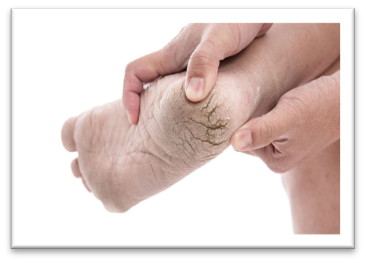
Fig.no.02: Depiction of foot crack[8]
BACTERIAL INFECTION:
Bacterial contamination in foot breaks happens when microbes enter the skin through fresh injuries or crevices. Staphylococcus aureus and Streptococcus species are two common types of bacteria that can cause infections in the feet.[9]
Symptoms of a bacterial infection in foot cracks may include:
1. Increased pain or discomfort
2. Redness and swelling around the cracked area[10]
Bacterial contaminations are sicknesses that can influence your skin, lungs, brain, blood and different pieces of your body. If left untreated, foot cracks may result in bacterial infections.[11]
Ointment:
A Ointment is a semisolid readiness applied to the skin or mucous films for restorative or defensive purposes. It normally comprises of a base, which can be water-solvent or greasy. Ointments are thicker than the creams and lotions.[12]
There are several types of ointments:
- Medicated Ointments
- Emollient ointment
- Protective ointment
- Herbal ointment
- Ointment For Wound healing
- Ointment for Acne[13]
Ointment Bases:
The following are some typical Ointment bases:
- Hydrocarbon Bases
- Retention Bases
- Water-Dissolvable Bases
- Oleaginous bases
- Hydrophilic Treatment Bases
- Anhydrous Bases[14]
Advantage:
- They are water soluble; hence, very easily can be removed from the skin.
- Helps in good absorption by the skin.
- Good solvent properties.[15]
Disadvantages:
- Limited uptake of water. Macrogols dissolve when the proportion of water reaches about 5%.
- Solvent action on polyethylene and Bakelite containers and closures.[15]
MATERIAL AND METHODS

Table no.01: List of Active Herbal Ingredients and Excipient with their sources
Instruments:

Table no.02: List of Instruments used
Method:
Preparation of plant extract: The dried plant material (leaves) is used for extraction. The fresh plant of part dried by air-cured method which is carried in the shade outdoors, after complete dried of leaves. Mix finely divide powder by grinding method. Extraction of Thuja Occidentalis done by hot-continuous method/Soxhlet extraction method, in which 50 gm of finely divided powder is filled in extractor. Ethanol is used as a solvent in extraction which is filled in boiling flask and condenser are connected to it for condensation process. It take 24 hrs to complete extraction process and to collect extract in a boiling flask. Collected extract evaporate on water bath for 2hrs and we get concentrated extract.[16] % Yield = weight of extract/ weight of ground powder material*100. [17]

Fig no.03: Soxhlet extraction
Thin layer chromatography: Each solvent extract was subjected to thin layer chromatography (TLC) as per conventional one-dimensional ascending method using silica gel Gas stationary phase. The mobile phases, results and chromatograms are depicted in following figure:[18]
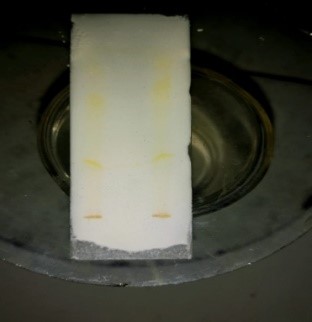
Fig no.04: TLC of Thuja Occidentalis
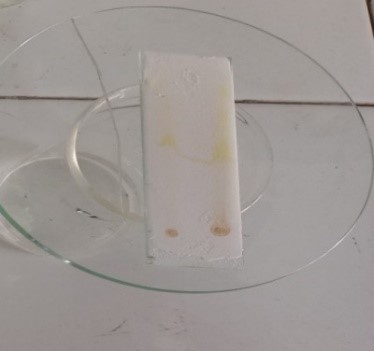
Fig no.05: TLC of Euphorbia Caducifolia
Development of herbal ointment formulation:
Ointments are prepared by following methods:
By the fusion method, all or some of the components of an ointment are combined by being melted together and cooled with constant stirring until congealed.
- Clean all the glassware and dry them properly as per SOP.
- Weigh all the ingredient properly.
- Take hard paraffin and cetostearyl alcohol. Melt them in porcelain dish and kept on water bath.
- To above melted mixture add wool fat, white soft paraffin, camphor and extract then stir well.
- Add turmeric and rose water to the oily phase. Maintain 70-75oC. Stir continuously until a uniform ointment is formed.
- After melting all ingredients, remove it from a porcelain dish.
- Pour it into an air tight container and place it in a cool and dry place.[19]
FORMULA:

Table no 03: Control batch formulation of Herbal Ointment
BATCHES PREPARED

Table No.04: Formula of preparation of herbal ointment.[20]
Evaluation of Herbal Ointment:
- pH
The pH of all the formulated Herbal Ointment was measured by using digital pH meter. First, pH meter was calibrated with standard buffers (pH4 and 7). pH of products was measured 20min, 30min, 1 hour after preparation. The test was repeated three times.[21]
2. Appearance and Homogeneity
The developed individual and polyherbal Ointment were evaluated for physical appearance and homogeneity by visual observation.
3. Viscosity
Brookfield DV-III viscometer was used for the determination of viscosity. At first, viscometer was calibrated by Brookfield Viscal Kit. Ointment samples were placed at room temperature for 30min.
Then, they were poured in apparatus container. Number 74 spindle was attached then viscosity was determined at 25°C and 100–250 rpm. The results were reported in average after triplicate experiments. [22]
4. Spreadability
The spreadability of the Ointment formulations was determined by measuring the spreading diameter of 1 g of Ointment between two horizontal plates (20 cm x 20 cm) after one min. The standard weight applied on the upper plate was 125 gm.[23]
5. Skin Irritation Test
Skin irritation studies were carried out in order to detect irritation and sensitization under conditions of maximal stress which may occur over a prolong contact with the skin surface. Skin irritation test is done by using patch test on the back skin of volunteer. Ointment (F2) (2×2 cm2) was applied to the clean skin of the volunteer back. Volunteer was then kept under observation for a period of 4-6 hours to detect any sign of erythema, redness, sensitization or any other allergic reaction.[24]
6. Stability Study
Formulation of Antibacterial Herbal Ointment became stored in the refrigerator and oven. Also stored beneath room temperature for three weeks modifications acquired if any are noted.[25]
7.Antibacterial Study
The antibacterial screening of Herbal preparation was done by cup-plate method. The Ointments were tested against bacterial agents namely S. aureus and E. coli. A loopful of the pure bacterial culture was suspended in nutrient broth and incubated for 24 hours. Nutrient agar media was sterilized and poured into petri plates. After solidification, 0.1ml of the inoculum was spread over the agar evenly using a rod. 6mm diameter cavity was prepared and formulated Ointment is placed in the cavity. A standard antibiotic was used as the control. The inoculated plates are incubated for 24 hours. Later, the zone of inhibition around the disc was measured and recorded.[26]
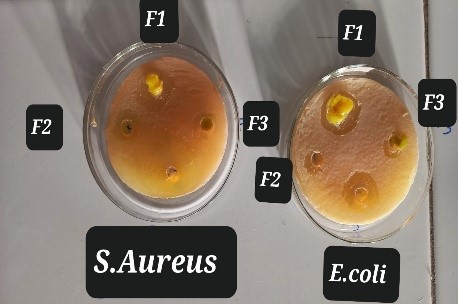
Fig.no.06: Antibacterial test
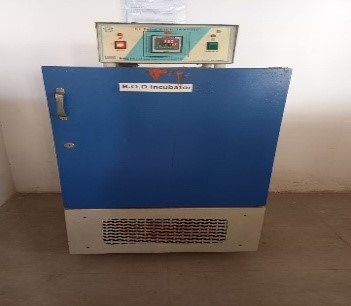
Fig.no.07: BOD Incubator
RESULT AND DISCUSSION:
Characterization and identification of plant extract
- Physical properties: Colour and odour was studied.

Table no. 05 Physical properties of Thuja Occidentalis Extract

Table no. 06 Physical Properties of Euphorbia Caducifolia Juice
- Solubility studies: Solubility in water, alcohol and Glycerin and Acetone was studied

Table no. 07 Solubility study of Thuja Occidentalis Extract

Table no. 08 Solubility study of Euphorbia Caducifolia Juice
PRELIMINARY PHYTOCHEMICAL SCREENING OF PLANT EXTRACT
Preliminary phytochemical test for identification of phytoconstituents in Thuja Occidentalis and Euphorbia Caducifolia.

Table no.09: Phytochemical screening
Thin layer chromatography: The thin layer chromatography of Thuja Occidentalis extract and Euphorbia Caducifolia juice was found to be-

Table no.10: TLC of Thuja Occidentalis extract and Euphorbia Caducifolia Juice
Evalaution of Herbal Ointment:
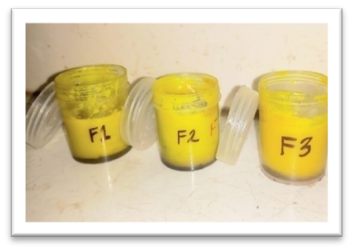
Fig.no.08: Formulation F1, F2, F3
- pH Of Ointment: The pH of Thuja Occidentalis and Euphorbia Caducifolia Ointment was found to be-

Table No.11: pH of ointment

Fig. No.09: pH of Ointment
- Physical Appearance: Color, odour, thickness was studied.

Table No.12: Physical Appearance
- Solubility: Solubility of Herbal Ointment in water, alcohol, Glycerin and Propylene Glycol was found to be-

Table No. 13: solubility of Ointment
- Spreadability:-The spread ability test of Herbal Ointment was found to be-

Table No.14: Spreadability
- Skin irritation test: The skin irritation test of given formulation of Thuja Occidentalis and Euphorbia Caducifolia show no reaction.

Table No.15: Skin irritation test
- Viscosity: viscosity of the ointment was found to be-

Fig. No.16: Viscosity of Ointment
- Washability: Washability of the Thuja Occidentalis and Euphorbia Caducifolia ointment was found to be-

Table No.17: Washability test of Ointment
- Anti-microbial test: Anti -microbial test of formulation F1, F2 and F3 was performed against microbes such as S Aureus and E Coli.
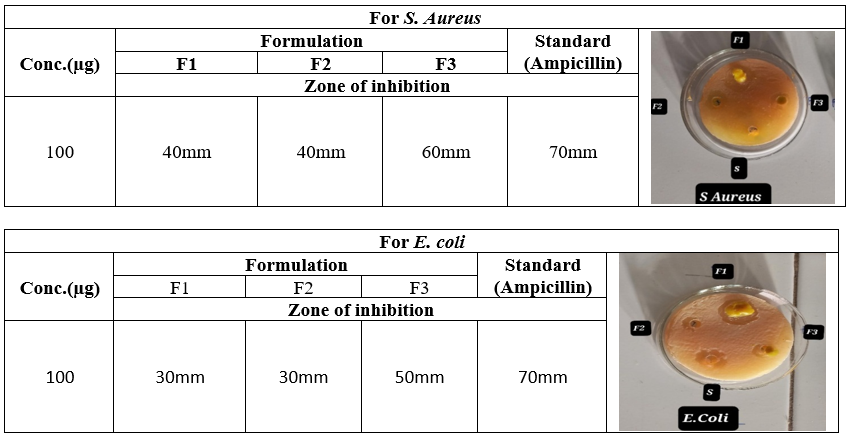
Table no.18: Antibacterial activity of herbal ointment
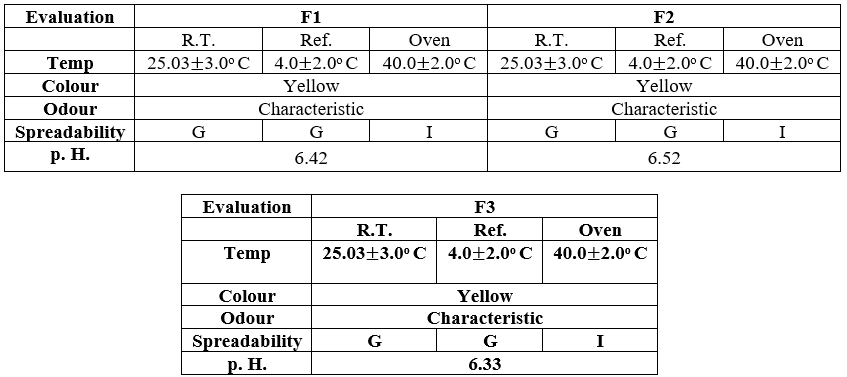
Table no.19: Stability study
- Comparison between Herbal Formulation and Marketed Formulation
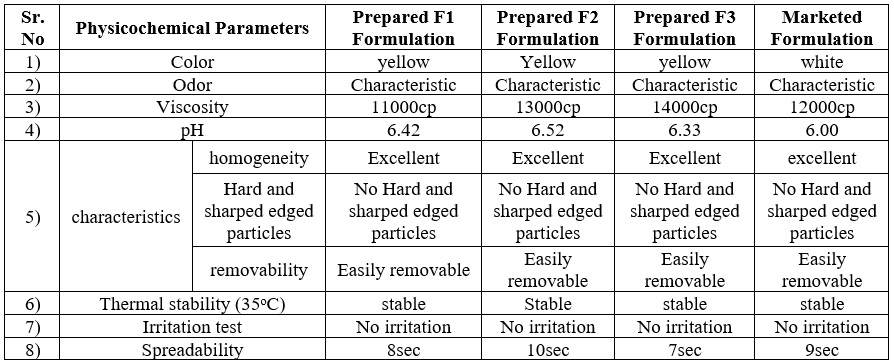
Table no.20: Comparative studies of formulated preparation and marketed preparation.
DISCUSSION:
The colour of all the formulated Herbal Ointments yellow and all the Herbal Ointments were good in homogeneity. The pH of all the formulated Ointments were in the range of 6.3-6.6 matching with skin pH range. Viscosity of all the Herbal Ointments was ranging from 11000-15000 cp at 20 rpm measured with Brookfield viscometer. The batches was found to be stable at room temperature and refrigerator. The spreadability all Herbal Ointments was in the range of 7-10 sec. All the formulated Herbal Ointments show good Anti-Bacterial activity.
CONCLUSION:
From the present investigation it has been revealed that herbal ointment of plant Thuja Occidentalis leaves Extract and Euphorbia Caducifolia Juice can be formulated using simple ointment base with other ingredients and the evaluation of physical parameters show satisfactory observation. The prepared herbal ointment give potent action against tested pathogens i.e S. aureus and E.coli which was comparable with standard antibiotic i.e ampicillin. The formulations F1, F2 and F3 were prepared with the different proportions of extracts the study shows the F3 batch was found to be optimum. It consist of 1g of thuja occidentalis and 0.5g of euphorbia caducifolia juice. Also F3 batch was found to be stable at room temperature and refrigerator. This batch was found to be better and effective for the crack heels and gives optimum anti-bacterial action.
ACKNOWLEDGEMENT:
The success and outcome of this project required a lot of guidance and assistance from many people. I am extremely privileged to have got this all along with the completion of my project. All that I have done is only due to such supervision and assistance which I cannot forget to thank.
I am highly thankful to the Department of Pharmacy, MANOHARBHAI PATEL INSTITUTE OF B. PHARMACY, KUDWA, GONDIA for providing various facilities like library facility during literature survey, laboratory, and chemicals/reagents facilities during experiments and many more.
I delightedly wish to express my respect and gratitude to the Principal Mrs. Manisha Mishra as well as my Guide Ms. Priyanka Raut for her support and encouragement for leading all the facilities required to proceed with our study.
I also express my deep gratitude to the Mr. Ankit P. Gondane, who took a keen interest in the project work and guided me all along till the completion of my project work by providing all the necessary information for a good system.
I am also thankful to Mr. Navin Tank and all those people who directly or indirectly co-operated me for completion of the project. At last but not the least, I express a deep sense of gratitude to my parents, family and friends for their kind and valuable support.
REFERENCES
- Durgesh W. Moharkar, Ashish D. Lande, Pranali D. Shahare, Dr. Mohammad Tauqeer Sheikh, Adesh S. Meshram “Development and evaluation of Aloe-vera gel loaded crack cream” published by iconic research and engineering journals, ISSN No: 2456-8880, Volume 6, Issue 6. December 2022, pg no:88.
- https://www.researchgate.net/figure/Schematic-representation-of-basic-human-skin-anatomy-depicting-the-different-skin-layers_fig1_362551152.
- Sanika P. Mukkirwar, Srushti S. Mukkirwar, Vibhavari m. Chatur, Sanjay G. Walode “Development and evaluation of herbal foot crack gel” published by world journal of pharamaceutical research ISSN 2277-7105 volume11 issue January 2022 pg. no. 1558.
- Dr.V.Sreedhar, K.Nihal Nawaz, M. Nagalakshmi, M.E. Pavithra, S. SaiSekhar “Formulation and evaluation of foot care herbal cream in the management of foot cracks” published by International Journal of chemistry and pharmaceutical sciences ISSN No: -2321-3132 volume 5(3) in 2017 pg. no. 89.
- Puja Haridas Wadekar, Vaishali Potnis “A review on Heel Fissure and its Management” published by International Journal of research in Engineering, science and management. ISSN No: 2581-5792, volume 4, Issue 2, February 2021.pg.no.96.
- Ying Li, Rong-HuaBao, Zhi-Qiang Jiang and Huo-Yanwu “Complications in operative fixation of calcaneal fractures” published by Pakistan journal of medical sciences, PMID No: 27648028, Jul-Aug 2016.
- Dr. Nidhi N. Chauhan, Mrs. Parul Vasaval, Dr. Mohammad Shoaib Patel “ Comparision of formulated and marketed herbal crack cream by evaluation parameters” published by International Journal of Creative Research Thoughts ISSN No:2320-2882,volume 8,issue 2, February 2020,pg no:62.
- https://vedix.com/blogs/articles/how-to-heal-cracked-heels.
- Dr. Nagham Mahmood Aljamali, ZainabH.Al- Zubaidy,Asaed H Enad “bacterial Infection and common bacterial Diseases: A Review” published by mat journals ISSN No:2582-4457, July-december 2021.
- https://www.verywellhealth.com/what-is-a-bacterial-infection-770565.
- Venkataramana Arbettu Padmanabha, Jayaganeshsankar, Jainendra Malakar “Evaluation of foot creams formulation on human skin- A novel approach” published by World Journal of Pharmacy and pharmaceutical sciences, ISSN No:2278-4357,volume 6,issue 9,2017, pg no:248.
- Muthukumar, Noori Irfana Parvin ,M K Shobana, Vimala, Vinesha, “ Formulation and Evaluation of Novel Herbal ointment for the treatment of fungal infection” published byResearch Journal of Pharmacy and Technology, ISSN No:0974-3618, March 2021,Page no:1459.
- Avish D Maru, Swaroop R. Lahoti “ formulation and evaluation of ointment containing sunflower wax” published by Asian Journal of pharmaceutical and Clinical research, ISSN No: 115-120, volume 12,Issue no 8, 2019, Page no:116.
- Rajveer Bhaskar, Monica Ola, Prakash H Patil and Kalpesh S Nawandar, “A Review on ointment and ointment Bases” Published by World Journal of Pharmaceutical Research, ISSN No:2277-7105, Volume 5,issue 9, 2016. Page no: 335.
- Dev Kaushal and Nikita Upadhyaya “Review on ointment” published by International Journal of Pharmaceutical sciences and Medicines (IJPSM), ISSN No:2519-9889.Volume 7,Issue 10, October-2022. Page no: 30-38.
- AmgadA.Awad, EI-Gied, Abdul kareem, Hamedelniel, “ Investigation of cream and ointment on antimicrobial activity of MagniferaIndica extract” published by Journal of advanced pharmaceutical technology and research, April-jun 2015.
- K.R. Khandelwal (2007) practical pharmacognostic techniques and experiments by Nirali publication.
- Rajatrashmi, Manisha Sarkar and Vikramaditya “ Pharmacognostic studies of Thuja Occidentalis Linn.- A Good remedy for warts and tumours, used in Homoeopathy” Published by journal.lww.com Vol.no.XIX(1&2) July 99 pg.no.52-58.
- A book “dispensing pharmacy” by R.M. Mehta and published by Nirali prakashan page no.23.7
- Fereidoon Pourbastani ,Gilbert,AZ “Heel crack healing composition and method thereof” published by United states patent application publication .pub. No:US 2001/0005721A1,Jun.28,2001 pg no:2.
- VirendraV.Patil, YogeshS.Thorat, NageshS.Kote, AvinashH. Hosmani “Formulation and evaluation of crack cream from plant extracts” published by International Journal of Curent Pharmaceutical Reasearch ISSN No:0975-7066,volume 12, issue 3, January 2020,page no:131.
- R.K. Tsatsop, G. Dijobie, K. Regonne, V. Bama, A. Mbawala, M. Ngassoum “ Optimization of Rheological Properties in the Formulation of an Ointment base from natural ingredients” Published by International journal of scientific and technology research, ISSN No-2277-8616, Volume 6, Issue 09, September 2017. Pg.no.115.
- Bakhrushina Elena O, Anurova Maria N, Zavalniy Michael S, Demina Natalia B, Bardakov Alexander I, Krasnyuk Ivan I, “Dermatologic Gels spreadability measuring methods comparative study” Published by International Journal of applied pharmaceutics, ISSN No. 0975-7058, vol 14, Issue 1, 2022.pg no-166.
- https://www.hindawi.com/journals/jt/2019/5979546/
- Viviane Cecilia Kessler Nunes Deuschle, Regis Augusto Norbert Deuschle, Mariana Rocha Bortoluzzi, Margareth Linde Athayde “Physical chemistry evaluation of stability, spreadability, in vitro antioxidant, and photo-protective capacities of topical formulations containing Calendula officinalis L. leaf extract” Published by Brazillian journal of pharmaceutical sciences, Vol no.51, jan.2015.
- Chandrakant Kokare“ pharmaceutical microbiology experiment and techniques” published by career publication, third edition, ISBN13-978-81-88739-81-3, September 2010 page no. 68-72.
- Junaid .R. Shaikh, Matsyagandha Kishanrao Patil, quantative test for preliminary phytochemical screening: An overview P-ISSN: 2349-8528. www.chemijournal.com.
- Anja Klancnik, Sasa Piskernik, Barbara jarsek, Sonja Smole Mozina, evaluation of diffusion and dilution method to determine the antibacterial activity of plant extract. Journal of microbiological method . ISSN No. 121-126 . 2010.
- Dr.R.Manavalan ,Jamshiyashamsu “ Formulation and evaluation of herbal skin cream for wound healing” R.V.S. college of pharmaceutical science,Sulur,Coimbatore-641402.
- Mr. Pathan Shabajsohil, Prof. Dr. Hingane. L.D.“Formation and charectarization of crack heels cream from alovera and bees wax” published by International Journal of Research Trends and InnovationISSN 2456-3315, in 2022; volume 7, issue 6 pg. no. 1243.


 Ms.Priyanka Raut*
Ms.Priyanka Raut*





























 10.5281/zenodo.10968574
10.5281/zenodo.10968574